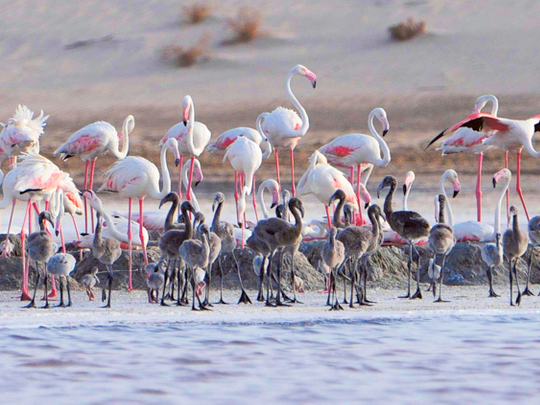
Abu Dhabi: A set of magnificent flamingoes has once again selected Abu Dhabi emirate’s Al Wathba Wetland Reserve as a breeding ground, with 110 chicks hatching in the protected reserve this summer.
They selected two sites within the wetlands, and the chicks hatched in June and July, the Environment Agency – Abu Dhabi (EAD) announced in a statement sent today (October 12).
“The continued breeding of flamingoes at Al Wathba Wetland Reserve is a result of the EAD’s effective management of this important habitat,” said Dr Shaikha Salem Al Daheri, executive director for terrestrial and marine biodiversity at the EAD.
The Greater Flamingo is a migratory bird, and its range stretches from the western Mediterranean Basin to Sri Lanka and South Africa. The UAE itself is not within its breeding route, but birds of the species have been settling in Al Wathba since 1998 to hatch and raise their young.
The reserve is a 45-minute drive from Abu Dhabi city, and a safe refuge for many species of reptiles, small mammals and insects. Around 200 flamingo chicks hatched at the site last year.
“Because flamingoes are sensitive breeders, whenever they select Al Wathba, we know that conditions there are good. The water quality is not too low to allow access to predators like foxes and dogs, and not too high to submerge the terrestrial nests. There is also enough food available for the birds,” Dr Salim Javed, manager of terrestrial assessment and conservation at the EAD, told Gulf News.
The presence of flamingoes on the site also contributed to Al Wathba’s recognition as a Ramsar site by intergovernmental sustainability organisation Ramsar Convention on Wetlands.
This month, the site has been partially opened to visitors by the EAD, but Dr Javed said that care is taken not to disturb nesting flamingoes.
“We manage the inflow of people and restrict access to breeding areas. For those who want to see the birds in action, we allow them to catch a glimpse from a distance or use remote cameras,” he explained.
Earlier this year, the EAD also announced that it now makes use of conservation drones to further assess and monitor flamingo populations in the reserve. The drones capture footage of flamingoes in areas that are difficult to reach, thus allowing for the verification of species numbers, and also take aerial pictures of birds and their nests.












